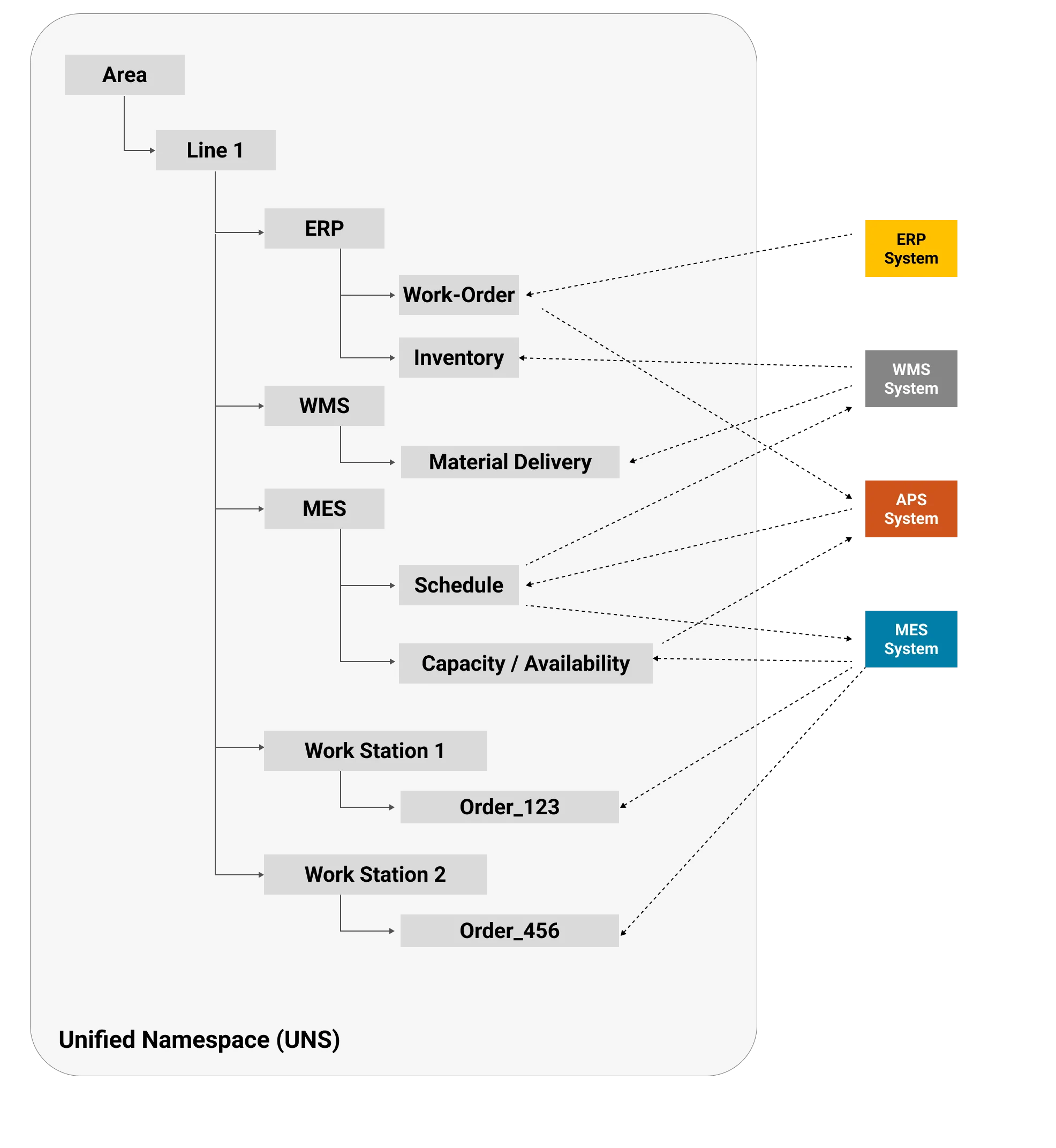Enabling Digital Work Order Management with a Unified Namespace (UNS)
As manufacturing operations grow in complexity, traditional methods of creating and tracking work orders—often reliant on paper, spreadsheets, or standalone software—can no longer keep pace. The need for real-time communication, accurate data, and rapid decision-making has driven the move toward digital work order management. By integrating tasks like work order creation, assignment, progress monitoring, and tracking into a single, unified data ecosystem, manufacturers gain greater visibility and control over the entire production cycle.
The Unified Namespace (UNS), an open and standardized data framework, which serves as a powerful catalyst for this digital transformation. In this blog post, we explore how UNS enables real-time work order visibility and coordination, ensuring that managers and operators share the same up-to-date information and can respond more quickly and accurately to changes on the shop floor.
Challenges of Traditional Work Order Management
Despite the technological advances available to industry, many manufacturers still face persistent issues when work orders are managed in a fragmented or semi-manual fashion:
Limited Visibility and Manual Data Entry
In many plants, data is scattered across siloed tools—spreadsheets, paper forms, or separate databases. This often leads to delays in updating work orders and inconsistencies in the information used by different departments.
For example, a supervisor might mark a work order as completed on a paper form, and that update doesn’t reach the ERP or scheduling software in a timely manner. As a result, other teams continue to plan resources or materials based on outdated information, causing inefficiencies and confusion.
Inconsistent Assignment and Oversight
Work orders can pass through multiple stages (e.g., machining, assembly, quality checks), but if each stage uses a different system or method to manage tasks, tracking progress becomes difficult. An order that requires painting, for example, may sit idle because the department responsible is unaware it’s ready for processing. Meanwhile, production schedules fall behind due to misplaced or incomplete updates.
Poor Resource and Cost Management
Manual entry and disconnected systems make it hard to record and analyze the time spent, materials used, and labor costs for each work order. A manufacturing plant may underestimate labor hours or material consumption for certain jobs, causing budgets to balloon and production managers to scramble for additional resources at the last minute.
Delayed Feedback and Reporting
Generating performance metrics on work orders—such as on-time completion rates, quality issues, or rework statistics—often relies on after-the-fact data gathering. By the time a weekly report reveals a recurring bottleneck in assembly, the plant has already suffered lost productivity and possibly missed shipping deadlines.
Requirements for a Digitalized Work Order Management System
To address these challenges, an effective digital approach to work order management must fulfill several key requirements:
Real-Time Task Creation and Assignment
Automate the workflow of creating work orders and assigning them to specific machines, cells, or personnel.
Provide clear instructions and checklists to operators and technicians, so they know exactly what needs to be done and by when.
Integrated Progress Tracking
Track the status of each work order from creation to completion, capturing data on time, costs, and resources.
Offer live dashboards that stakeholders (managers, planners, quality teams) can consult to see how production is advancing.
Seamless Communication Across Systems
Ensure that data flows automatically between systems such as ERP, MES, and scheduling platforms.
Eliminate the need for repetitive manual data entry, reducing the risk of error and duplication.
Centralized Data and Reporting
Provide a single source of truth that consolidates all work order information into a unified view.
Generate automated reports to evaluate performance metrics and help identify bottlenecks or opportunities for improvement.
Integration of Quality Control and Compliance
Tie quality checks directly into work order steps to ensure that any non-conformances are captured in real time.
Maintain full traceability of who worked on each order, what materials were used, and any test results required for compliance.
How the UNS Framework Enables Effective Digital Work Order Management
A Unified Namespace provides the open, standardized communication layer necessary for real-time coordination among systems like ERP, MES, WMS, and even PLCs. By publishing and subscribing to relevant data topics, these systems maintain accurate, synchronized views of active work orders without relying on fragile, point-to-point integrations.
Work Assignment (MES)
The MES listens to scheduling data published in the UNS (for instance, from an APS or ERP scheduling module). Whenever a schedule change or a new work order is published (e.g., /mes/schedule), the MES updates its internal roster of upcoming work orders.
The MES then publishes details of available orders to relevant machine or production cell topics under the UNS. This means that Operators get a real-time queue of upcoming tasks, significantly reducing downtime and waiting periods.
 With all assignments and updates flowing through the UNS, changes in the schedule—like expedited orders or machine maintenance—are instantly visible to everyone who needs that information.
With all assignments and updates flowing through the UNS, changes in the schedule—like expedited orders or machine maintenance—are instantly visible to everyone who needs that information.
Work Order Activation (MES → Machine → PLC)
On the shop floor, an operator selects an order to run from the MES interface. The MES immediately publishes an update to a namespace like:
/work_station_1
order_id: 123
status: activeThis indicates that work order #123 is in progress on Work Station 1.
Once the machine’s PLC, which is subscribed to a relevant namespace on the UNS, detects that order 123 is active, it automatically loads the necessary recipe or parameters—either from local storage or by downloading them if needed.
As production proceeds, machine sensors and controllers publish performance data and completion status back to the UNS. Hence, managers and planners can see progress metrics updated in real time, ensuring they have accurate information on resource usage, labor, and any unforeseen delays.
Unified Data Ecosystem for Cost, Time, and Performance Analysis
Because each update (e.g., start/stop times, material usage, labor hours) is published to the UNS, generating accurate cost and time metrics for each work order becomes seamless. This data can be stored in a specialized database (e.g., the MES, ERP, or a data historian) subscribed to the relevant UNS topics.
At the end of each production run, reports can be immediately compiled for managers to evaluate performance and compliance. Detailed records help teams spot trends—like recurring machine stoppages or quality issues—so they can initiate process improvements.
From the moment a new task is published by the ERP to the point where the MES activates it on the shop floor—and the PLC configures machinery accordingly—the UNS provides the single source of truth. This integrated, transparent data flow not only accelerates production cycles but also empowers managers with the insights they need to continuously refine costs, processes, and quality. The end result is a more agile, resilient, and data-driven manufacturing operation.
Conclusion
Digital work order management powered by a Unified Namespace (UNS) transforms fragmented, manual processes into a streamlined, real-time ecosystem. By enabling seamless data flow between systems like ERP, MES, and PLCs, the UNS ensures that everyone—from planners to operators—works from a single source of truth. This eliminates delays, reduces errors, and empowers manufacturers to respond swiftly to changes on the shop floor.
With greater visibility, accuracy, and control, manufacturers can optimize resources, improve quality, and accelerate continuous improvement—turning digital transformation goals into everyday operational success. Stay tuned to the HiveMQ blog as I share another use case in an upcoming post.

Kudzai Manditereza
Kudzai is a tech influencer and electronic engineer based in Germany. As a Sr. Industry Solutions Advocate at HiveMQ, he helps developers and architects adopt MQTT and HiveMQ for their IIoT projects. Kudzai runs a popular YouTube channel focused on IIoT and Smart Manufacturing technologies and he has been recognized as one of the Top 100 global influencers talking about Industry 4.0 online.
